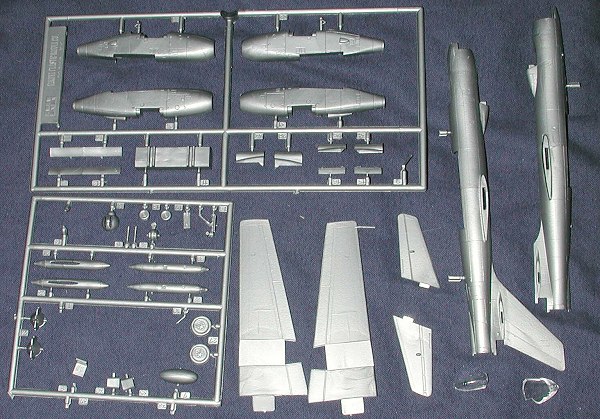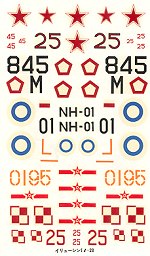
|
KIT: |
Tamiya 1/100 IL-28 Beagle |
|
KIT # |
PA 1015 |
|
PRICE: |
?? OOP for at least 25 years |
|
DECALS: |
five aircraft |
|
REVIEWER: |
|
|
NOTES: |

|
HISTORY |
Designed in the late 1940s with an orthodox configuration, the Il-28 was powered by Rolls-Royce turbojets supplied by Britain just before the Cold War started. Two Klimov VK-1 centrifugal-flow turbojets (developed from the Rolls-Royce Nene) were mounted beneath the wings in pods, which extend beyond wings’ leading and trailing edges. The high-mounted wings featured a straight leading edge and forward-tapered trailing edge with blunt tips. The unswept wing contrasts with the swept tail plane but ensures pitch control in high Mach dives. The tubular fuselage was cigar-shaped, and tapering to the rear, with a rounded, glassed-in nose and bubble canopy. The WWII-style greenhouse contains the bombardier/ navigator's electronics and visual bombsight. The tail fin is swept-back and tapered with a blunt tip. The tail of the Beagle contains the rear gunner/radio operator and two more 23mm NR-23 cannon. Flats are low-mounted on the fin, swept-back, and tapered with blunt tips. A glassed-in tail gunner compartment is to the rear of the tail.
It is armed with two 23 mm NR-23 cannon in a fixed nose installation and two 23 mm NR-23 cannon in the tail turret. Up to 3000 kg of disposable stores can be carried in a lower fuselage weapons bay. The Il-28R variant is a three-seat tactical reconnaissance version with four or five cameras. This model was also used for electronic intelligence gathering with a revised electronic fit. The Il-28U variant is an operational conversion trainer lacking radar and armament but fitted with a second cockpit in the nose.
The Il-28 was retired from the Soviet Air Force and Navy in the 1980s,
serving as target tugs and ECM platforms. It also served with a large
number of export customers, and was exported to over 20 countries].
Beagles served with most of the major Arab air forces. The arrival of 50
Il-28s in Egypt in 1956 was alarming to the Israelis, and a significant
factor in the origins of the 1956 Suez War, in which all the Il-28s sent
to Nasser were destroyed on the ground. Again in 1967 and yet again in
1973, the Il-28 featured as a significant ground target for the Israeli
Air Force. During the Cuban Missile Crisis of 1962, Soviet Premier
Khrushchev agreed to remove the offensive missiles as well as the medium
range twin-jet Il-28 "Beagle" bombers being assembled in Cuba. Il-28s
also saw service with the Nigerians during the Biafra War. East Germany
and Finland flew only the target-towing version, without armament. By the
early 1990s more than 300 Beagles remained in service with a number of
ex-Soviet allies and clients. Today most of them have been retired, as
much due to lack of spare parts as anything.
|
THE KIT |

Back in the 1970s, Tamiya came out with a variety of modern aircraft kits
in 1/100 scale. Bolstered by their success in converting armor modelers to
1/35 from 1/40 and 1/32 scale, they tried to do the same in aircraft with
1/50 and 1/100 scales. These did not meet with any real success as 1/48 was
firmly entrenched in the US and 1/144 was quite popular for airliners.
Around this same time, Mania and a few other smaller Japanese companies
produced some other kits to this scale, but it has been decades since any
new 1/100 kits have appeared.
Too bad as these are, for the most part, not that bad at all. They have engraved panel lines (albeit a trifle on the 'heavy' side) and fairly good detailing for the size. This kit had no problems with sink areas, flash or ejector pin marks, even on the one-piece wings and horizontal stabilizers. There is even a bomb bay with doors that can be displayed open. The cockpit is basically a seat and the wheel wells have no detail. However, we are talking 1970s here on this one.
Instructions are totally in Japanese with several exploded views showing construction of the model and a photo of some Polish Beagles in flight. All of the decal and color info is on the back of the box. Most IL-28s were in bare metal or aluminum lacquer, though one of them is in green upper with light blue undersides. Decals are still nice and white with no yellowing, even after all these years. Markings are provided for a Russian, Polish, Indonesian, Finnish and Chinese plane. With some 'make your own' decals, other, more exotic IL-28s like those from Egypt or Nigeria can be done.
|
CONCLUSIONS |
These really are neat kits and while the scale is a bit off the beaten path, will make into very nice models with a bit of care.
If you would like your product reviewed fairly and quickly by a site that has over 200,000 visitors a month, please contact me or see other details in the Note to Contributors.